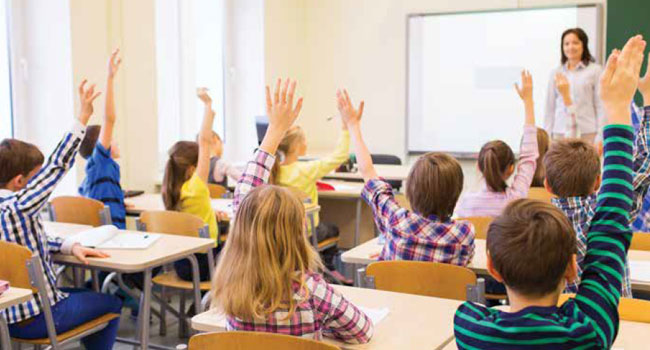
Class In Session
How analytics and video surveillance are changing the face of learning
- By Jumbi Edulbehram
- Nov 01, 2016
THREATS TO SCHOOLS, INCLUDING ACTIVE SHOOTERS,
THEFT, VANDALISM AND BULLYING, ARE NUMERABLE
AND GROWING. TO MITIGATE THESE RISKS, EDUCATIONAL
INSTITUTIONS HAVE BOOSTED SECURITY PRACTICES
AND TECHNOLOGY DEPLOYMENTS. THERE IS AN
INCREASING DEMAND FOR SURVEILLANCE CAMERAS
CAPABLE OF RUNNING VIDEO ANALYTICS SOFTWARE
TO CAPTURE TOTAL SITUATIONAL AWARENESS AND
ELEVATE SECURITY COVERAGE.
Video analytics enable schools to proactively recognize behaviors to
create an efficient and safe environment with minimal disruption. The
ability to capture behavior patterns and track a scene, both retroactively
and in real time, make it easier than ever before to recognize
trends and patterns. This analysis can be critical in the case of a security
investigation, but it can also be used to improve operations. For
example, densely populated areas of a school can present a challenge
for administrators in the event of a serious emergency. Video analytics
help pinpoint potential issues proactively and allow administrators to
make these areas safer for students.
Data analytics, on the other hand, examine raw data from various
sources with the purpose of drawing conclusions about that information,
and can be used to measure student engagement and offer administrators
an inside look at how students perform in the classroom, engage
with lesson plans or understand the material. Data analytics is used in a
number of institutions to allow leaders to make better gather intelligence
and enhance the educational experience.
The combination of information gathered by using both video analytics and data analytics can create a complete picture for teachers and administrators to
streamline educational offerings and pinpoint
whether students are truly engaging with lesson
plans. In this article, we will examine how
both methods for streamlining operations
and educational experiences are being used in
a campus environment, and how schools can
begin to use the data in a positive way for
serving students and teachers.
TEACHER AND STUDENT
EMPOWERMENT THROUGH
VIDEO AND DATA ANALYTICS
Reaching far beyond security use cases, video
footage, coupled with analytics software is
now emerging as a means to address learning
objectives in some educational facilities.
Specific to the use of video only, according
to a recent study conducted by Harvard University,
video observation of teachers and students
in the classroom can contribute to
heightened awareness of classroom activities.
The research found that using recorded video
of real lessons to conduct teacher evaluations
resulted in more constructive feedback.
According to the study, recorded video of a
lesson allows administrators to highlight
what teachers do best, but also identify areas
for improvement.
Many teachers now believe that capturing
video of a lecture or lesson is beneficial for
education. Many educators who want to offer
students the best possible educational experience
welcome the use of video. On the other
hand, there may still be a reluctance to embrace
the initiative because of the fear of being “spied
on.” School administrators can help address
these concerns by engaging with teachers on
positive uses for the footage, discussion of how
the footage will be used and dispersed, and
answering questions as they arise.
Along the lines of data analytics in education,
schools are implementing ways that allow
students to self-report on engagement in the
classroom. The idea is that students can track
their engagement with lectures and seminars
and report how they spend their time, as well
as how it compares with other students in the
course. Students are responsible for selfreporting,
and software analytics is used gather
the information from the various student feedback,
aggregating it to allow teachers and staff
to see how students are performing, or where
they are struggling.
The overall benefit is that teachers can be
alerted when there’s a particular section that
is challenging, when a student may need more
one-on-one attention or when someone is
falling behind on their workloads. As the
technology becomes more developed, schools
aim to deliver actionable insights from the
data to be used in streamlining educational
goals and ensuring students are taking charge
of their education investment. Allowing students
to directly use analytics to improve the
quality of student/teacher engagement in the
classroom is another benefit of having analytical
tools in the classroom. Pairing these
analytics with video results in an even more
robust method for improving education,
learning and overall operations.
BUILDING SECURITY INTELLIGENCE
Data collected through video from security
cameras used in the classroom, coupled with
the data collected through student engagement
measurements is irrelevant without
being organized into easy to understand and
easy to use information that creates a wealth
of intelligence for today’s organizations.
Analytics makes it possible for officials to
gather intelligence from various sources and
apply it to security practices, effectively and
quickly identifying possible threats, managing
emergency situations and efficiently
investigating incidents.
Analytics software allows schools to have
better insight into risk mitigation, which is a
necessity in today’s environment. Through
the implementation and deployment of analytics
software, both K-12 and college campuses
can reach new heights in regards to
centralized data and security management,
streamlined response to threats and the identification
of possible issues that could put students’
lives at risk.
Although these analytics have proven
valuable in security, they’re slow to be widely
adopted. With new applications and use
cases that involve more than the security
department, multiple parts of the organization
can see value in
deployment of cameras
and utilization of video.
This article originally appeared in the November 2016 issue of Security Today.